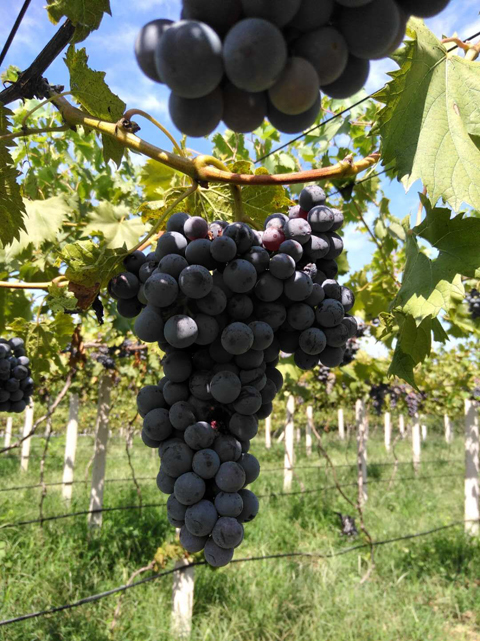

Evaluation on Alkaline Salt Tolerance of Grape F1 Generation Hybrids
Received date: 2017-01-19
Accepted date: 2017-03-06
Online published: 2017-03-06
We evaluated alkaline salt tolerance in four hybrids of Vitis amurensis cv. ‘Zuoshan1’ × ‘SO4’ (A11, A14, A15, A17) and 2 hybrids of V. amurensis cv. ‘Zuoshan1’ × ‘101-1’ (B24, B26) to assess the physiological response of these hybrids and identify the strains with high alkaline salt tolerance as candidate rootstocks for saline-alkali land. Rootstock 1103P and V. vinifera cv. ‘Crimson Seedless’ were conducted as double controls. The potted grapevines were irrigated with 100 mmol∙L-1 NaHCO3 (pH8.62). Comprehensive assessment was based on principal component analysis and correlation analysis. The plant height, root activity, leaf and plant water content were reduced under NaHCO3 treatment, whereas the electrical conductivity, MDA content, soluble sugar and free proline content were increased. The plant height of A17 was minimally affected. The plant water content was slightly reduced in Crimson, A17 and B24. The difference in root activity of A14 and A15 was not significant, compared with that of their own controls, and the difference in electric conductivity of 1103P, B24, A14, B26, Crimson and A15 was not significant, compared with that of their own controls. MDA content for B26, A17 and A15 did not differ from that of their own controls. Soluble sugar and free proline content of A15 increased the most after NaHCO3 treatment. According to the D value, A14, A15, B24 had strong alkali resistance; Crimson, A11 and A17 had medium alkali resistance; and 1103P and B26 had weak resistance.

Key words: grape; hybrid rootstock; alkali salt tolerance
Guo Shuhua , Zhai Heng , Han Ning , Du Yuanpeng . Evaluation on Alkaline Salt Tolerance of Grape F1 Generation Hybrids[J]. Chinese Bulletin of Botany, 2018 , 53(1) : 51 -58 . DOI: 10.11983/CBB17015
| [1] | 陈少裕 (1991). 膜脂过氧化对植物细胞的伤害. 植物生理学通讯 27, 84-90. |
| [2] | 樊秀彩, 张亚冰, 刘崇怀, 潘兴, 郭景南, 李民, 王姣 (2007). NaCl胁迫对葡萄幼苗叶片有机渗透调节物质和膜脂过氧化的影响. 果树学报 24, 765-769. |
| [3] | 郭瑞, 李峰, 周际, 李昊儒, 夏旭, 刘琪 (2016). 亚麻响应盐、碱胁迫的生理特征. 植物生态学报 40, 69-79. |
| [4] | 马凯, 汪良驹, 王业遴, 姜卫兵, 顾平 (1997). 十八种果树盐害症状与耐盐性研究. 果树科学 14, 1-5. |
| [5] | 秦红艳, 沈育杰, 艾军, 李昌禹, 王振兴, 杨义明, 范书田 (2010). 盐胁迫对不同葡萄品种叶片中叶绿素荧光参数的影响. 中外葡萄与葡萄酒 (5), 35-38. |
| [6] | 石德成 (1992). 胁迫下植物的胁变反应及数学分析. 植物学报 34, 386-393. |
| [7] | 石德成, 盛艳敏, 赵可夫 (1998). 不同盐浓度的混合盐对羊草苗的胁迫效应. 植物学报 40, 1136-1142. |
| [8] | 王海英, 孙建设, 王旭静 (2000). 果树耐盐性研究进展. 河北农业大学学报 23(2), 54-58. |
| [9] | 王军, 周美学, 许如根, 吕超, 黄祖六 (2007). 大麦耐湿性鉴定指标和评价方法研究. 中国农业科学 40, 2145-2152. |
| [10] | 武维华 (2008).植物生理学(第2版). 北京: 科学技术出版社. pp. 448-449. |
| [11] | 许兰杰, 梁慧珍, 余永亮, 杨红旗, 董薇, 牛永光, 芦海灵, 曹杰, 吕爱淑 (2016). 盐碱胁迫下芝麻种子萌发过程中营养物质的动态变化规律. 河南农业科学 45(4), 43-48. |
| [12] | 张宪政 (1989). 植物生理学实验技术. 沈阳: 辽宁科学技术出版社. pp. 329-330. |
| [13] | 赵世杰, 史国安, 董新纯 (2002).植物生理学实验指导. 北京: 中国农业科学技术出版社. pp. 45-48, 55-57, 84-85, 130-133, 142-143. |
| [14] | 周广生, 梅方竹, 周竹青, 朱旭彤 (2003). 小麦不同品种耐湿性生理指标综合评价及其预测. 中国农业科学 36, 1378-1382. |
| [15] | 周万海, 师希雄, 曹孜义 (2009). 盐胁迫对不同葡萄砧木苗期生长特性的影响. 甘肃农业大学学报 44, 60-63. |
| [16] | Carroll B (2006). Rootstocks for grape production. In: Division of Agricultural Sciences and Natural Resources. Stillwater: Oklahoma State University. HLA-6253-4. |
| [17] | Mehanna HT, Fayed TA, Rashedy AA (2010). Response of two grapevine rootstocks to some salt tolerance treatments under saline water conditions.J Hortic Sci Ornament Plants 2, 93-106. |
| [18] | Verma SK, Singh SK, Krishna H (2010). The effect of certain rootstocks on the grape cultivar ‘Pusa Urvashi’ ( Vitis vinifera L.). Int J Fruit Sci 10, 16-28. |
| [19] | Yang CW, Shi DC, Wang DL (2008). Comparative effects of salt and alkali stresses on growth, osmotic adjustment and ionic balance of an alkali-resistant halophyte Suaeda glauca(Bge.). Plant Growth Regul 56, 179-190. |
/
| 〈 |
|
〉 |